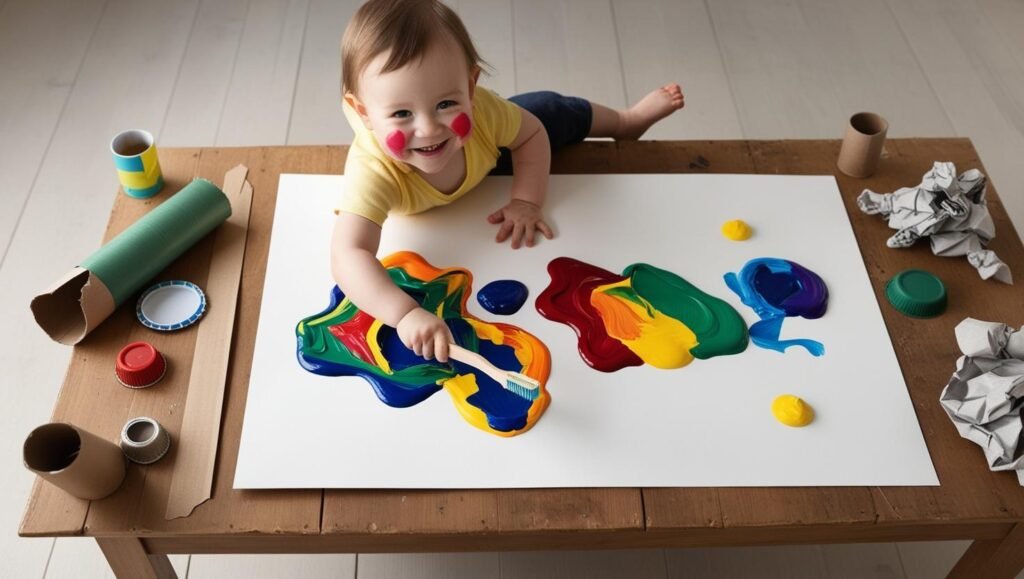
Managing a daily routine with children at home can be challenging, but it’s also a great opportunity to foster child development through creativity. There’s no need for expensive toys or sophisticated materials—with simple everyday objects, you can offer practical, educational, and very fun activities.
In this article, you will find activity suggestions using accessible materials, ideal for children aged 2 to 6, which support motor, cognitive, emotional, and social development.
Why Use Simple Materials?
Activities with everyday materials:
- • Develop creativity and imagination
- • Promote reuse and environmental awareness
- • Stimulate critical thinking and problem-solving
- • Are economical and easy to organize
By exploring household objects in a playful and educational way, children expand their perception of the world and learn through play.
10 Practical Activities with Everyday Materials
- 🎨 1. Toothbrush Painting
Materials: Paper, tempera paint, old toothbrush
How to do it: Dip the toothbrush in paint and guide the child to make splashes or free drawings. Great for motor coordination and artistic expression.
- 🍝 2. Collage with Colored Pasta
Materials: Dry pasta (fusilli, penne, spaghetti), paper, glue, food coloring
How to do it: Color the pasta with food dye and glue it on paperboard to form pictures or patterns.
- 🧦 3. Sock Puppet
Materials: Old sock, buttons, yarn, hot glue or sewing kit
How to do it: Create characters with socks for puppet theater. Excellent for stimulating language and imagination.
- 🧂 4. Drawing with Colored Salt
Materials: Salt, food coloring or crayons, glass jars
How to do it: Place salt in jars and add coloring or grated crayons. Layer different colors in a jar. Enhances visual perception and focus.
- 📦 5. Blanket Fort
Materials: Sheets, chairs, clothespins
How to do it: Build a fort to create a reading or play corner. Encourages pretend play and autonomy.
- 🧃 6. Recycled Musical Instruments
Materials: Cans, yogurt pots, rice, grains, rubber bands
How to do it: Create drums, shakers, or homemade guitars. Supports sound perception, rhythm, and coordination.
- 🎯 7. Bowling with PET Bottles
Materials: PET bottles, small ball
How to do it: Use bottles as pins and knock them over with a ball. Develops balance, strength, and gross motor coordination.
- 📍 8. Memory Game with Bottle Caps
Materials: Bottle caps, stickers or duplicate images
How to do it: Stick pairs of images and play memory with your child. Stimulates attention and focus.
- 🧵 9. Spaghetti Threading into Strainer
Materials: Kitchen strainer, uncooked spaghetti
How to do it: Invite the child to thread the pasta into the holes. Simple sensory activity, great for fine motor skills.
- 🎁 10. Sensory Box
Materials: Cardboard box, fabrics, grains, small toys
How to do it: Create a box with objects of different textures and sizes. Stimulates touch, curiosity, and language.
How to Adapt Activities by Age Group
Age Activity Adaptation
2–3 years Focus on textures, colors, and broad movements
4–5 years Introduce simple rules and logical challenges
6 years Increase complexity and encourage autonomy
Tips to Get the Most Out of the Activities
- • Organize a creation corner: Prepare a box with basic materials like paper, glue, blunt scissors, containers, ribbons, and paint.
- • Value the child’s creations: Display drawings, take photos of their projects, or keep them in a special folder.
- • Encourage active participation: Let the child choose materials and suggest ideas.
Conclusion
The best games don’t always come from stores—many are found in kitchen drawers, clothing closets, or the recycling bin. With creativity, love, and a willingness to engage, you can offer unforgettable educational moments for children. Make the most of household objects to turn your everyday life into a true workshop of learning and fun!
